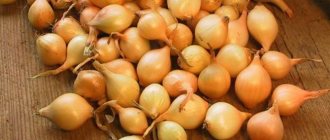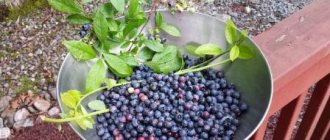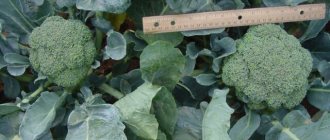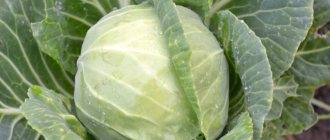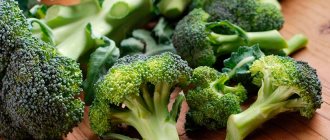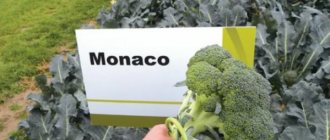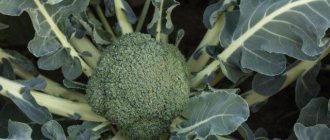Home » Garden and vegetable garden » Vegetable garden » Vegetables
Irina Borodina 05/31/2020
2161 View
Traditional types of cabbage - white and cauliflower - are often planted in our gardens. Many gardeners know about the abundance of cabbage varieties, but they are treated with doubt and do not always know how to cultivate and what to prepare from unusual forms.
Dietary and healthy options include broccoli, which is just gaining a place in our garden beds. Broccoli grows well in open ground in the middle zone (Moscow region) and produces an excellent harvest, and the benefits for the body are simply invaluable.
Brief characteristics of vegetable crops
Broccoli belongs to the Cruciferous family
It originates from the Mediterranean, but its pedigree is not known for certain. It was obtained in Italy by simple selection several centuries ago, when there was no idea about selection.
It is genetically close to cauliflower, which was bred by hybridization from broccoli. Although some botanists claim that it was the other way around.
They are similar in appearance and form inflorescences collected in a head. The cauliflower inflorescences are very dense, while the broccoli are looser.
Modern broccoli has 200 varieties that have spread throughout the world. Such abundance and growing needs indicate its value as a dietary and vitamin product.
Biological characteristics of vegetable crops:
- the stem grows up to 60-90 cm;
- bush large, spreading;
- at its top peduncles with small, green buds are formed, which are edible;
- buds of small flowers form a head of green, blue or emerald color;
- the inflorescence head differs in shape, forming conical and round outlines;
- forms additional flower stalks on side shoots;
- has a different weight (150-700 g and even 1 kg), which is influenced by the variety;
- the leaves are large, whole and slightly corrugated, located on long petioles;
- characterized by cross-pollination;
- main varieties: capitate and stem;
- the growing season lasts from 50 to 150 days, which depends on the speed of ripening of the variety.
There are winter and spring varieties. In the regions of Russia, spring broccoli with a green head is most often grown. This is a hybrid variety that belongs to the Italian green branched variety.
Early varieties form lateral heads simultaneously with the central one. In later ones, they are formed after cutting the central one. The ability to form heads on stepsons significantly increases productivity, lengthening the growing season.
Temperature
Broccoli is a vegetable of a temperate climate - mild and humid, characterized by cool summers and not too cold and long autumns.
Frost resistance of broccoli, temperature regime:
- the seedling tolerates temperatures down to -3 °C;
- adult plants can withstand frosts down to -5 °C;
- broccoli tolerates low and high temperatures better than cauliflower;
- low temperatures can lead to freezing during flowering and rotting;
- the high temperature causes the heads to bloom quickly.
The head ripens best at temperatures from 18 to 23 degrees. Therefore, this vegetable is often grown for the autumn harvest.
Growing for a summer harvest is possible, but is hampered by high temperatures and lack of water. In such conditions, plants produce a harvest of poor quality - the heads have an irregular shape, deformed (severely swollen) buds, yellow-green color, and the bushes form hypertrophied leaves.
In extreme conditions, plants will prematurely set small and swollen heads. This phenomenon is also sometimes observed during late spring cultivation, when there is high temperature and drought. A poor harvest can be obtained in conditions of prolonged flooding of plantations, when plant roots do not have conditions for proper respiration.
In regions where temperatures rise quickly in the spring, it is better to grow broccoli in the fall, because a sharp increase in temperatures will lead to improper formation of the plants and heads. Therefore, depending on the location, advice on when to plant broccoli varies. If your region's spring is warmer than fall, you can try growing it later to produce larger heads. Then it is recommended to plant the plants at the end of summer.
Benefits and nutritional value
It is difficult to overestimate the benefits of a Mediterranean product
Broccoli is a dietary product; its calorie content is 34 kcal/100g. Vegetables are a real “vitamin-mineral cocktail” for the body, which contains macro- and microelements, vitamins B, PP, E, C, K, carotene (provitamin A). Proteins contain a number of essential amino acids, for which broccoli can compete with beef and chicken eggs. The main % comes from simple carbohydrates or sugars.
In terms of benefits and diverse chemical composition, broccoli occupies a leading position compared to its closest cabbage relatives. Used in baby food, useful for older people.
This is a means for the prevention and treatment of:
- atherosclerosis;
- vascular and heart diseases;
- nervous disorders;
- gastrointestinal diseases;
- malignant neoplasms;
- radiation sickness.
Broccoli has an excellent taste, reminiscent of green asparagus. Hence its second name – asparagus cabbage. And young leaves are not inferior in nutritional value to spinach and kale.
Broccoli has been part of the traditional Italian diet for 1.5 thousand years. A European eats up to 5 kg of healthy vegetables per year. There has been an increased demand for this variety of cabbage all over the world. In terms of consumption, it is only a fraction of a percent inferior to everyone’s favorite – white cabbage.
Description
Unlike most types of cabbage, the edible leaves of this species are not the leaves, but the unopened green inflorescences. The closest relative of broccoli is cauliflower, which is more familiar to our people.
This is an annual crop that bears fruit over several months, which is a huge plus for gardeners. After cutting one head, several lateral ones are tied to the plant at once. Productivity depends on two factors: care and variety.
Broccoli (also known as cabbage) is a succulent; nutrient reserves accumulate in thick, elastic stems, so the vegetable is more resistant to drought and frost than its closest relatives, which makes growing it easy.
Features of care
Correct and timely watering significantly increases the yield of vegetable crops
How to grow broccoli without much hassle? Caring for the “Italian” includes traditional gardening chores. It is necessary to place special emphasis on watering and controlling pests and diseases, since the tender leaves and tasty heads attract the attention of not only people.
In general, the vegetable adapts well to the continental climate of the Russian expanses, stoically enduring heat and cold, winds and sudden changes in weather. It is unpretentious and quite suitable for growing in Russian open spaces.
Biological features:
- Illumination . Grows well in a bright, open place. In poor lighting, loose and small heads form, so it is best to position the bed from east to west
- Temperature regime . Feels great in a moderate range from +16 to +20C. At elevated temperatures, the heads become loose and flower shoots appear. Withstands light frosts: -2C (young plants) and -7C (adult plants)
- Watering and air humidity . Optimal soil moisture is 70% and air moisture is 80%. This regime can be created by sprinkling. In its absence, regular watering is necessary so that moisture penetrates to a depth of 15-20 cm, otherwise the asparagus cabbage will go to waste. On average, watering is carried out every other day, but it all depends on weather conditions. Automatic watering is convenient, which automatically waters deep layers of soil. It is useful to moisten the foliage and spray it
- Soils . These are light, moisture-intensive, nutrient-rich formulations with neutral acidity. Deep topsoil guarantees good root growth
- Weeding and loosening . Held regularly. Allows you to destroy the soil crust and get rid of a number of pests that readily move from weeds to cabbage
- Feeding . A minimum of three feedings are recommended, aimed at the growth of the ground part and the formation of the head. When the central part is cut off, the growth of the lateral parts is stimulated with the help of fertilizers.
- Hilling up . When the inflorescence begins to form, hilling is carried out, raking a layer of earth under the bush. This stimulates the growth of additional roots.
Growing Broccoli
Do not pull out the plant after removing the main head. It will take some time for the lateral inflorescences to appear from the axillary shoots. This will bring additional harvest. Their development and formation do not require shading, like cauliflower.
Agricultural technology for growing broccoli - planting and care
The soil for planting must contain the necessary nutrients. The site has been prepared since the fall. The most convenient fertilizer is nitrophoska, which contains 12-17% nitrogen, phosphorus and potassium, and its application will not allow you to make mistakes if you do not know the chemical composition of the soil in your area. Apply nitrophoska at the rate of 40g per 1 sq.m. It is very useful to add fertilizers containing boron and molybdenum.
- In the spring, before planting, I recommend checking the lunar calendar and determining the most convenient day for this. Landing is carried out on the waxing moon. Pay attention to the crops that grew in this place.
Bad predecessors:
- cabbage
- beet
- tomato
- turnip
- radish
- radish
Good predecessors:
- green manure
- carrot
- potato
- onion
- legumes
- grain cucumbers
- Dig up the selected area, after adding 1 cup of ash per 1 sq.m. and organic fertilizers in the form of humus or compost, at the rate of half a bucket per 1 sq.m.
- Level the bed and water it with phytosporin solution.
- Make holes based on the sowing geometry attached to your variety. For example, for the Tonus variety, the sowing geometry is as follows: the distance between rows is 60 cm, between plants 20-30 cm.
- Pour water into the holes, 2-3 liters into each hole.
- Remove the seedling from the cassette, place it in a hole, cover it with soil (2-3cm above the root collar) and press it down a little. Be sure to sprinkle dry soil or mulch on top, this will prevent the formation of a crust on the surface of the soil.
It is better to plant seedlings in the afternoon. In this case, moisture will remain in the ground longer and there will be no strong illumination by direct rays of the sun.
Subsequent care for broccoli consists of watering, weeding and periodic feeding. Feed the plant twice:
- the first time 2-3 weeks after planting
- the second time, after the heads are tied on the cabbage
Fertilize with mullein solution in a ratio of 1:10, at the rate of 1 liter of solution per bush.
After watering, if you do not use mulch, be sure to loosen the soil.
Closely monitor the appearance of pests on the leaves, be it flea beetles or butterflies, as well as the appearance of diseases such as blackleg. With this disease, the affected areas of the stem darken, it becomes thin, rots and breaks.
The causes of this disease are excess air humidity, dense planting, and lack of ventilation. When symptoms of the disease appear, water the plant with a solution of potassium permanganate at the rate of 0.5 g per 1 liter of water. After two weeks, repeat the treatment.
Planting broccoli in open ground
Based on the climate zone, asparagus cabbage in open ground is obtained by seedlings and without seedlings
Sowing seeds
Cabbage seeds are small, round, have good germination
In the western regions and the Urals, broccoli is grown by sowing seeds in the ground. The signal for sowing is the average daily air temperature of +10C.
When it has been stable for a week, and the buds have awakened on the apple tree, then it is time to sow the seeds. Usually the timing is the end of April - beginning of May. With this method, ripe heads appear in the second ten days of July.
You need to prepare the seeds in advance:
- They are sorted, selecting the largest specimens
- Selected seeds are immersed in water at t=+50C for 15 minutes, and then dipped for a minute in cool liquid at t=+10C. This technique helps the seeds awaken
- It is useful to add Epin solution (growth stimulant) and keep them in a warm solution for 8 hours, “provoking” the seed to germinate
- Then hardening is carried out in the refrigerator during the day.
- The seeds are dried and then planted as seedlings.
Prepare in advance a plot with loose, fertile soil, neutral or slightly alkaline in composition (acidic soil is not suitable!) After sowing the seeds, wait until 3 leaves appear. Then the bed is thinned out.
Leave 30-40 centimeters between plants. Carry out regular evening watering, based on weather conditions. When the seedlings acclimatize and take root, they are fed with a weak solution of manure (1:20) or a urea preparation (according to the instructions). This will help enhance the growth of tops: the entire above-ground part.
The conveyor method is convenient when the seeds are sown in March in three periods with a frequency of 2 weeks. Then the asparagus cabbage ripens gradually and the “green conveyor” with vitamins and minerals will be replenished uninterruptedly.
An important point is the choice of variety. The best broccoli varieties do not guarantee success for gardeners. The variety must be zoned (adapted) to a specific climatic zone.
The area where cabbage has been planted continuously for 4-5 years is unsuitable for further planting of this vegetable crop. Disease spores and larvae of cabbage pests accumulate in the ground. Predecessors after which broccoli grows well are tomatoes, cucumbers, legumes, carrots, garlic, onions.
Growing through seedlings
Seedlings need moderate temperatures to grow
Heads of asparagus cabbage will appear as early as June if you use the seedling method for planting broccoli. Seeds are prepared in mid-March using the same techniques as for planting in the ground.
Containers are selected and washed in advance, filling them with purchased soil mixture. It is easy to prepare it yourself by adding humus and peat (2:1:1) to the turf soil. Drainage is placed at the bottom of the container.
In theory, you need to sow the seeds, cover them with 1 cm of soil, then wait for germination. In practice, the temperature at home is higher than normal, and for the Mediterranean culture to germinate, it only needs +15-+17 C. On the windowsill it will stretch out greatly and will not turn out strong and stocky.
Let's reveal some secrets of growing:
- Seeds are sown in oblong containers or other containers, making grooves 1 cm deep in the soil, covered with cling film to prevent drying out and cold weather, and placed in a greenhouse. This event is planned for late March - early April
- At t=+10C the first sprouts appear after 10 days. At +15-+18C the seeds will hatch in 3-4 days
- After 2 weeks, 3-4 true leaves are formed. This is a signal for a pick
- The cabbage is transplanted into peat pots and kept for another 10 days at t=+21C. If the sun shines too brightly, the seedlings shade
- It is a good idea to feed the seedlings with nitrogen or complex fertilizers, reducing their concentration, since the root system of seedlings is quite delicate
- After 40-50 days of growth with a number of leaves of 5-6 pieces, it is time to plant in open ground. This period occurs in mid-May
- Previously, a week before transplanting to the open sky, the temperature in the greenhouse is gradually reduced, carrying out the hardening procedure
Broccoli is planted according to the following scheme: 40 cm between holes and 50-60 cm between rows
Planting should be done in cloudy weather in the afternoon. Seedling placement pattern: 40x60 cm. Dig deep holes. This is necessary to fill them with the nutrient mixture.
An earthen substrate is added to each well and mixed with it (per well):
- compost;
- ½ cup of ash;
- 10 g complex minerals.
Broccoli should be planted by covering it with soil 2 cm above the root collar. Do not forget to compact the soil, while the stem is buried and remains in the hole.
If the days are sunny and hot, then the young seedlings provide shade. In the heat, the leaves quickly wither, losing their elasticity. The young plant does not adapt well to the heat and may die.
As the asparagus cabbage grows, it is hilled up to increase the volume of the root system and produce a larger plant. In this case, the level of the hole will be equal to the level of the bed.
How to properly plant broccoli seedlings is shown in the video:
How to grow BROCCOLI. Planting seedlings in open ground
Broccoli: cultivation and care in open ground, characteristics of varieties | (Photo & Video) + Reviews
Young cabbage plants are often “attacked” by the cruciferous flea beetle. Dusting leaves with ash mixed with tobacco dust repels the pest. Covering with a thin, non-woven fabric helps. If the leaves turn into a net, then the use of insecticides is necessary.
Fertilizing broccoli
It is useful to alternate organic and mineral fertilizers
There is no urgent need for fertilizing if, according to the rules of agricultural technology, the beds have been filled with fertilizers with phosphorus and potassium (for example, superphosphate and potassium sulfate) since the fall, and liming has been carried out. If autumn preparation has not been carried out, then fertilizing during the growing season helps out.
Feeding stages:
- The first is carried out when the seedlings take root in a permanent place and begin to grow. An infusion of mullein (1:10) or an infusion of bird droppings (1:20) is poured under the root. After 2 weeks, the procedure is repeated. Organic compounds supply the roots with nitrogen, which helps the cabbage gain weight and form the above-ground part
- During the second fertilizing, potassium humate is added to the soil. Another option is to prepare a fertilizer solution: 40 g superphosphate + 20 g ammonium nitrate + 10 g potassium sulfate per 10 liters of water
- After the central head is cut off, a third feeding is carried out to stimulate the growth of side shoots. To do this, mix 30 g of potassium sulfate + 20 g of superphosphate + 10 g of ammonium nitrate in 10 liters of water or a bucket
- As additional fertilizing, dusting with wood ash is used, watered with ash or herbal infusion. Broccoli responds well to watering with infusion of nettle or comfrey
It is useful to add a layer of humus under the vegetable, which simultaneously fertilizes the cabbage and serves as a mulching material.
Planting broccoli
Please note that cabbage especially needs nutrition when the main head is cut off and new inflorescences are formed from their lateral buds. After each feeding, the soil must be loosened and lightly mulched.
Preparing broccoli seeds for sowing
Before soaking, the seeds must be sorted out and the strongest and largest ones selected. Then place the material in hot water, about 50°C for 15 minutes. This will activate all processes of seed spillage. After this, immerse them immediately in cold water for 1 minute. Then the seeds should be kept in a solution with microelements and disinfected. To do this, mix 0.1 g of boric acid and 0.5 g of potassium permanganate in a half-liter jar of water. Soak the seeds in the solution for 12 hours. Then it will be useful for the seeds to be placed in a solution of wood ash (1 tbsp per half-liter jar) and left for 12 hours.
After fertilizing and disinfection, carefully rinse the seeds in clean water. Place the seeds on a clean cloth, wrap them in a plastic bag and keep the seeds for a day in the lower refrigerator compartment. Dry it a little, and our material is ready for planting.
Do not neglect preparing seeds for planting
The first shoots appear after 4-7 days.
Start the preparatory period and germination of seed material in March to grow broccoli in a greenhouse. Plant seeds sprouted in mid-April in open ground on warm May days.
Problems during cultivation
The greatest harm is caused by butterfly larvae, which are very voracious
Broccoli in open ground is constantly under attack from pests and diseases. For pests, tender cabbage leaves are a favorite delicacy, so it has many enemies. Cabbage parasites are easy to notice with the naked eye or by the characteristic traces they leave:
- large and small holes on leaf blades;
- eating leaves down to the veins;
- egg laying on the underside of the leaf;
- cobwebs or sticky liquid on the surface.
Cabbage is eaten by cabbage flies, aphids, whiteflies, butterfly larvae, cruciferous flea beetles, cruciferous bugs, slugs, moths, cutworms, and thrips. Based on the specific pest and the size of the lesion, treatment is carried out and “emergency measures” are taken.
Laundry soap
When using folk recipes, laundry soap must be included in their composition. Cabbage has smooth leaves, from which droplets of the solution easily roll off, without staying on the surface and without destroying the garden parasite. Soap makes the composition sticky.
Diseases are noticeable by other signs:
- the appearance of dry or weeping spots on the leaf blades;
- deformation of stems and leaves;
- plaque of different shades;
- color change.
Broccoli in open ground suffers from black ring spot, Alternaria, downy mildew, mucous bacteriosis, vascular bacteriosis, black leg, clubroot, linen, and fomoz. These are fungal and bacterial diseases for which certain protective measures are provided.
Blackleg is the most common seedling disease
There are prerequisites for the appearance of pests and diseases that should be taken into account when caring for broccoli:
- watering with cold water;
- abundance of weeds;
- excessive watering;
- high or low humidity;
- weak planting material;
- contaminated or poor soil composition;
- lack of crop rotation;
- thickened plantings;
- insufficient amount of light.
There are plants that are natural crop protectors. If you plant mint, celery or dill next to cabbage, then the vegetable will not be attacked by aphids, flea beetles and cabbage caterpillars.
You can plant vegetable crops nearby - neighbors of broccoli, which feel “sympathy” for each other without interfering with growth and development. These are beets, chard, potatoes, lettuce, onions, spinach. It is better to avoid planting beans and peas close together.
In addition to pests and diseases, broccoli sometimes has a serious problem - it goes into color. What to do if coloration develops? This video will help you solve the problem:
WHY DOES BROCCOLI GO IN COLOR!?
Broccoli: cultivation and care in open ground, characteristics of varieties | (Photo & Video) + Reviews
Diseases and pests
The main disease of broccoli is considered to be blackleg - a disease in which the root gradually rots. You can notice it by the fact that the broccoli foliage has changed color to a paler color and has become lethargic and stunted. When a root is pulled out of the soil, sunken, putrefactive, dark-colored destruction is visible.
It makes no sense to fight the problem, because it is determined at a later stage, when the fungal disease is already progressing at the highest level. Therefore, the main help against blackleg is considered to be preventive measures:
- disinfection of seeds and soil;
- loosening the soil and killing weeds;
- moderate watering;
- crop rotation;
- thinning plantings to ventilate the root part of broccoli.
The main insect pests of broccoli are slugs and caterpillars. To combat them, give preference to traditional methods:
- Infusion of potato or tomato tops. Fill 1/5 of a bucket of crushed plant material with 4/5 parts of water. Bring to a boil, boil for 3-5 minutes, and set aside in a warm place to infuse for a day.
- A solution based on tobacco dust, red hot pepper and laundry soap. Mix tbsp. l. pepper, a handful of tobacco, 40 g of soap and 10 liters of water. Let it brew for 2-4 hours. Strain and drizzle over broccoli. Do not forget that before eating such a composition, it is necessary to rinse thoroughly with running water.
- Crushed egg shells are good at repelling slugs.
Plant peppermint or marigolds next to the broccoli - caterpillars do not like the smell of their essential oils, which will protect the cabbage from attacks.
Among the chemicals, the drugs “Aktellik”, “Groza”, “Foxim”, etc. will help. Their use is possible subject to strict adherence to the rules and instructions.
More about cabbage diseases and pests is written in this article.
Overview of varieties
An unusually colored inflorescence is formed by the broccoli variety Miranda F1
The yield of a variety depends on its zoning, designed for cultivation in a certain region. The zoned variety quickly adapts, grows well, and produces excellent yields in the climatic conditions intended for it.
Varieties with the F1 icon are hybrids. They get sick less, ripen earlier, and are larger in size, but their seeds are not suitable for subsequent cultivation (seeds in the second generation do not produce excellent yields). In addition, they are somewhat inferior to ordinary varieties in their taste.
For the middle band:
- Baro star F1 is an early Korean hybrid with medium-grained heads, the weight of which reaches 800-1000 g; stored for up to 10 days;
- Fiesta F1 - early cabbage with dense, juicy inflorescences, the ripening period of which is 70 days;
- Comanche is an early ripening variety with dense inflorescences weighing up to 300 g, which tolerate transportation well;
- Curly head - ripens in 80-95 days, forming up to 5-6 inflorescences weighing 300-500g; is resistant to diseases;
- Tonus is an early-ripening, cold-resistant variety that is ready for use in 60-80 days; forms dense heads weighing 120-150 g.
- Vyarus is an early ripening variety with a mass of inflorescences of 200-300 g and a ripening period of 65-75 days; well forms additional heads from side shoots; resistant to low and high temperatures.
- Green Manjik F1 is an early Japanese hybrid that can be used after 60 days; forms dense heads, the weight of which varies from 300 to 700 g; resistant to many diseases and temperature changes.
Fiesta - an early variety of cabbage for the middle zone
For Siberia and the Urals:
- Lazar is an easy-to-care variety that forms dense inflorescences on the 70th day;
- Linda - dark green cabbage with heads weighing 300 g ripens on the 100th day;
- Tribute - distinguished by the earliest ripening and delights with juicy inflorescences weighing 200-300 g;
- Arcadia - an early variety characterized by high yield and the ability to tolerate low temperatures.
Among the Romanesco varieties there are early and mid-season hybrids that require careful care
An interesting cabbage with a romantic name, in which Italian notes are woven - Romanesco. This is one of the varieties of cauliflower, which is still classified as broccoli. Its light green color and spiky cone-shaped inflorescences give it an unusual appearance. Each large bud consists of smaller ones, creating an unusual configuration. In Italy, special dishes are prepared from it, as Romanesco heads have a delicate, nutty taste. Late harvested inflorescences turn yellow and become harsh in taste.
For the southern regions of Russia and Ukraine
Varieties of all 3 categories are suitable: early, mid-season, late. Late-ripening varieties ripen well in the southern zones:
- Atlantic - low bushes with a branched leaf rosette form dense inflorescences weighing 300-350 g;
- Monopoly F1 – well forms lateral inflorescences weighing up to 350 g;
- Monterey F1 - has an emerald color, does not form side heads, but the main mass reaches 1.7 kg.
Dutch late-ripening hybrids are also in demand: Bosphorus, Sumosun, Aurora, Kermit.
Broccoli variety Monterey f1
To ensure a bountiful harvest and varied inflorescences, plant varieties of different ages on the site. With extended fruiting, they will delight you with tasty, vitamin-rich products all summer long.
The most famous and popular varieties
Breeders offer the best varieties that will not disappoint the gardener. Group of early “record breakers”:
- Green Magic F1 has excellent taste, high marketability, the stem does not form voids, and disease resistance is observed. Disadvantage: with infrequent watering, the heads turn brown.
- Fiesta F1 is characterized by high yield, resistance to heat and Fusarium wilt. Disadvantage: when overripe, the heads become loose and crumble
- Naxos F1 ripens on the 80th day. Forms dense heads weighing 500-800 g. It has high marketability; when overripe, the heads do not darken. Characterized by resistance to heat and disease. Disadvantage: does not form lateral peduncles
A variety of Dutch selection, which is zoned everywhere
The best mid-season varieties:
- Batavia F1 ripens in 90-95 days. Forms a spherical, gray-green head weighing 500-700 g. Secondary heads grow on the sides. It has high taste, good productivity, and transportability. Disadvantage: the variety requires care.
- Heraklion F1 forms a round, flattened head weighing 500-600 g, which consists of small inflorescences, convenient for culinary processing. The growing season is 70-75 days. It is unpretentious, has good yield, and is heat-tolerant. The downside is that the seeds are sold only in professional packages for farms.
- Ironman F1 forms spherical heads weighing 400-600 g in 85-100 days. Ripens evenly, resistant to blooming and over-ripening. Has excellent taste. Disadvantage: high maintenance requirements.
Dishes with broccoli: varied, healthy, tasty
The best late-ripening varieties:
- Batavia F1 ripens in 90-95 days. Forms a spherical, gray-green head weighing 500-700 g. Secondary heads grow on the sides. It has high taste, good productivity, and transportability. Disadvantage: the variety requires care.
- Heraklion F1 forms a round, flattened head weighing 500-600 g, which consists of small inflorescences, convenient for culinary processing. The growing season is 70-75 days. It is unpretentious, has good yield, and is heat-tolerant. The downside is that the seeds are sold only in professional packages for farms.
- Ironman F1 forms spherical heads weighing 400-600 g in 85-100 days. Ripens evenly, resistant to blooming and over-ripening. Has excellent taste. Disadvantage: high maintenance requirements.
The delicate nutty taste allows you to prepare broccoli salads with cheese, garlic, tomatoes, peppers, zucchini, and other vegetables. They are seasoned with vegetable oil or sauce. Just don’t forget to boil the head first, dividing it into small inflorescence pieces.
Where and for how much is seed material sold?
Broccoli seeds are sold in specialized stores and online markets. They can be ordered by mail. The cost depends on the variety, the number of seeds in the package, wholesale, region of the manufacturer and the distance between control points. Eg:
- Flapru online store, Yekaterinburg: “Tonus” broccoli seeds 0.5 g (set of 20 packs) costs 180 rubles;
- online store “Seeds of high germination” Ryazan: broccoli seeds “Lord F1” 12 pcs. — 48.6 rub.;
- online store “SemenaOpt” Rostov-on-Don: broccoli seeds “Fiesta F1” from Holland 2500 pcs. — 1590 rub.
When purchasing seeds, carefully study the information on the packaging. If you sow a hybrid marked with the designation “F1” after the name of the variety, then the seeds collected from it will not carry the qualities of the parent broccoli. Hybrid seed will have to be purchased annually.
Harvesting
The green head consists of flower buds that are eaten
In the photo, the broccoli cabbage is cut when the head is ripening. Harvesting is carried out until yellow, blooming inflorescences appear. An overripe vegetable crop loses its original taste, although it is still edible.
Cabbage should be harvested starting from the central head, it should be dense, and the length of the stem should grow up to 10 cm. The stem is also eaten, it is tasty and juicy, like the apical part. The cut site is sprinkled with wood ash, leaving the vegetable to grow.
After this, they feed and wait for the lateral inflorescences to grow, which are smaller in mass but more delicate in taste. Harvesting is carried out in the early morning hours so that the inflorescences do not wither under the rays of the sun.
Storage of early varieties lasts up to 2 weeks in the refrigerator or cool room. And late varieties can last in storage or cellar for 2-3 months. But usually broccoli is cooked immediately or used to freeze. In winter, the “kochanchiki” are defrosted and a variety of dishes are prepared.
There is no need to throw the stems into the compost heap after harvesting. They are able to lie on the ground for a long time and, due to the accumulated nutrients, form small heads. And this is another chance to get fresh products.
Knowing how to care for broccoli in the garden and which varieties are suitable for your area, you don’t have to think long about purchasing tasty and vitamin-rich cabbage seeds. Caring for it is feasible and traditional, and the benefits and unique combination of medicinal properties allow you to maintain strength and health not only in summer, but also in winter.
3.7 Total Score
Customer ratings: 3.67 (3 votes)
Types of broccoli
Broccoli is a subspecies of cauliflower. It looks similar to her, only the inflorescences are not white, but green. Just like cauliflower, we eat the dense head, consisting of unopened flower buds.
It is important to know that two main types of broccoli are used as an agricultural crop:
Regular broccoli (the kind we are used to seeing in pictures and on store shelves). This type of broccoli is characterized by a large central head on a thick stem, consisting of inflorescences tightly adjacent to each other.
Italian or asparagus broccoli. This species is distinguished by many thin stems, each of which ends in small green heads.
Top dressing
Let's look at this aspect in more detail. How to properly grow broccoli in open ground? If you plan to get a full harvest of this crop, then during care you should definitely provide for the possibility of feeding. The plant can be fertilized quite often. The first feeding is carried out 12–14 days after planting cabbage in open ground. This period is considered the most important for plants, so they definitely need additional nutrients. Mullein solution is well suited for this purpose. Approximately 250 grams of fertilizer should be taken per bucket of water. To increase the nutritional value of the composition, you can add a teaspoon of urea to the solution. If mullein is not available, you can also use chicken manure, only in this case the ratio will be 1 to 20. Approximately a liter of fertilizing is required per square meter of soil.
The next feeding is carried out after 18–20 days. It is better to use nitrogen fertilizers for it. Ammonium nitrate works well. A matchbox will be enough for a bucket of water. The fertilizer consumption rate will be the same - one liter per square meter.
By the end of summer, a third feeding is carried out. During this period, broccoli requires phosphorus and potassium fertilizers. Take 30–35 grams of superphosphate and 9–11 grams of potassium sulfate per bucket of water. Watering the soil is carried out based on the calculation of 1.5 liters per square meter of soil.
During the first wave of harvest, the central head is usually removed. After this, the broccoli should be fed again. This stimulates the regrowth of side shoots. To do this, dissolve a tablespoon of nitroammophoska in a bucket of water. A liter of solution is poured onto each bush. A week after this feeding, you can add 150–200 grams of wood ash. For greater efficiency, the ash should be scattered over previously watered and loosened soil.
When to sow seeds for seedlings?
Asparagus cabbage is not a picky crop, but it grows better in a sunny area that is protected from the wind and has nutritious soil. Due to different sowing dates and growing seasons, it is difficult to clearly determine the time of planting and harvesting.
Therefore, broccoli has three groups: early-ripening, mid-ripening and late-ripening varieties.
When is it better to sow seeds: in autumn or spring? This question worries many summer residents.
And figuring out the landing time is really important. The fact is that for better ripening of cabbage heads, the most optimal temperature is from 7 to 21 °C. The ripening of inflorescences occurs best in the cool season. Therefore, it is better to plan planting at the beginning of August in order to harvest in October.
If asparagus cabbage is planted in the spring, then the seeds are sown as seedlings. Then the grown seedlings are planted early in open ground, and they will have time to ripen before the onset of hot weather.
When planting in autumn and spring, you need to take into account that with a prolonged drop in temperature around -4°C, you can lose the entire harvest. But short-term drops in temperature are not scary for the crop.
Disease Control
Broccoli is often affected by various fungal diseases, rot, mosaic, and downy mildew. Bordeaux mixture helps in the early stages of the disease, and during the formation of inflorescences, fungicides like Topaz should be used. It is necessary to stop processing no earlier than 7-10 days before harvest.
- plants do not require shade, so covering them from the sun is not necessary. However, they need to be shaded immediately after planting;
- If the gardener did not have time to harvest in time and flowers formed on the heads of cabbage, then do not be upset: even with them you get a tasty and healthy salad
- late varieties can be sown in late spring - early summer: it is possible to harvest up to 4 harvests per season;
- The central heads of cabbage, ready for harvesting, reach 12-14 cm in diameter, have a dark green color and closed buds. Usually it takes about 2 months before the first harvest from the moment the first shoots appear. It is best to harvest cabbage in the morning, when the crop is turgor. To cut plants, you should use a clean, well-sharpened knife.
Ofazende.ru
Containers and soil for sowing
Choose low containers up to 25 cm. You can use plastic or wooden boxes. The root system does not require sunlight, so the walls should be opaque. The soil for sowing is selected to be nutritious. You can buy it at a flower shop or collect it yourself: equal parts of turf, sand, humus and wood ash.
The first layer in the container is laid out drainage. It can be pebbles or expanded clay. Loose and permeable soil is laid by compacting, but not too much. Before planting seeds, it should be sprayed with warm melt moisture from a spray bottle or watered with rainwater. We make small grooves at a distance of 3 cm between them and retreating from the edges of the container. The seeding depth is 1 cm. The planting material is sown and covered with light soil, lightly compacted by hand.
Caring for broccoli seedlings
Now the fun begins. Broccoli, when the first sprouts appear, reacts sharply to temperature. To sprout tasty cabbage you need 19-20 degrees. As soon as the cotyledon leaves appear, it is lowered to 10-11 degrees. Next, adjust the temperature depending on the time of day and weather. If it is warm and sunny, then it is optimal to keep it at 15-17 degrees, on cloudy days - 12-13. At night we recommend lowering the temperature to +8-10. Young broccoli seedlings require high air and soil humidity. The optimal indicator is 80-85%. As for the soil, it should always remain slightly moist. Avoid overwatering seedlings, as this can cause fungal diseases, including blackleg.
Picking up broccoli seedlings
Plant picking should be done as carefully as possible. Broccoli has a delicate root system that is easily damaged. Therefore, use special tools to pull out the seedlings along with the roots. A regular wooden ice cream stick will do. Broccoli is harvested at the stage of appearance of true leaves or 2 weeks after emergence. When diving, containers should be filled with the same mixture as when planting seeds. It will be easier to care for young plants in the future. They require good lighting. But broccoli must be protected from direct sunlight. They injure young leaves and stems. The temperature after picking is the same - 20..22 degrees Celsius.
Approximately 2-3 days after picking the plants, the first feeding is needed. Use nitroammophoska. Before planting in open ground, broccoli is hardened: A few days on the balcony, gradually increasing the time spent in warm air. 2-3 days in advance - leave it outside overnight.
Optimal growing time
The best way to plant broccoli is through seedlings. Seeds should be planted in the first half of March. In this case, seedlings can be planted in the ground in mid-May, and harvesting in the technical ripening phase can be done in August-September. In warm regions, it is possible to sow seeds directly into the ground. They do this at the end of April. Seeds are placed in greenhouse soil from late March to early April.
For regions with short and cold summers, mid-season and early ripening varieties are selected. To extend the yield period and have fresh broccoli on the table for a long time, you can combine seedling and non-seedling methods. For example, plant seedlings in early May, and sow seeds in the beds from late spring to early summer every 2 weeks.
Important! Purchased soil does not need disinfection. Do-it-yourself soil is subject to mandatory etching. It is kept in the oven, over steam, in the microwave, and sprinkled with boiling water or potassium permanganate.
Requirements for soils and planting site
Broccoli loves cool weather, sunlight (at least 6 hours a day), it needs enough water and fertile soil.
Broccoli requires soil with the following characteristics:
- fertile;
- well drained;
- humus;
- with high moisture capacity;
- the soil reaction should be close to neutral (pH 6.5-7.5).
It cannot be grown after:
- other cabbage vegetables;
- oilseed rape;
- mustard.
Good predecessors:
- wheat;
- barley;
- triticale.
Description and biological features of broccoli
This vegetable plant is a type of cauliflower. The head of broccoli looks very different from other cabbage crops. It consists of branched stems, at the ends of which there are modified dark green buds. There are varieties with white, purple or blue inflorescences.
Important! Varieties with a head color other than green are grown as a biennial crop. The fruit of such varieties ripens only in the second year.
There are varieties with different colored heads
The plant grows as an annual. The agricultural technology for its cultivation is very similar to that applicable for the colored “relative”. Regarding soil structure, broccoli is less demanding than many other cabbage species.
